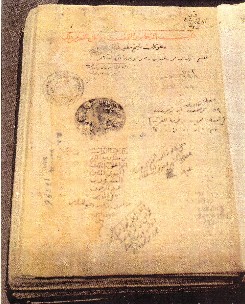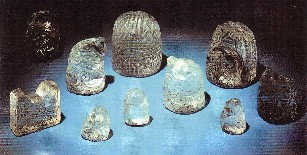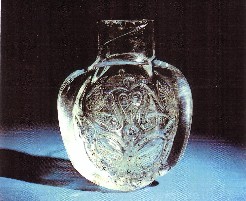
To next page
Al-Awhadi (compiler form an earlier version of 11th century)(d1408) Kitab al-Hadaya wa al-Tuhaf (Book of gifts and rarities)
----------------------------------
The title page of the Kitab al Hadaya wa al-Tuhaf


Left; Rock crystal bottle, Fatimid Egypt. Early 11th century
Although the pieces shown are not the ones talked about in the book it was for sure on the market in Cairo that Nasir ibn Khusraw found rock crystal from East Africa
�34 During the days of lent, Salamah b. Sa�id (the christian secretary of Shuja, the mother of al-Mutawakkil) sent al-Mutawakkil (some of) their (christian) food in colored Chinese pottery (ghudar Sini), and bowls (jamat) of rock cristal (billawr), (placed) inside round baskets lined with leather (juwan) embellished with (hallaha) gold and silver. He sent in them some of their Lenten food, which he had intensely desired for (the caliph). The expense (for this) amounted to three thousand dinars.
�42 In the year 832 AD, al-Hassan b. Sahl offered (Prince) al-Mu�tasim bi-Allah, during the reign of his brother al-Ma�mun bi-Allah, a thousand platters (tabaq) from the Khazar, Kimak and Toguz Oghuz (countries); and several extraordinary beads (or balls) (habbat) of rhinoceros horn (khatu), together with good knives (sakakin) (with handles) of rhinoceros horn, and (other) enormous knives (with handles) of bezoar (bazahr).
�46 On Nawruz day, in the year 895�����
Among the things made for al-Mu�tadid was a dome (qabbah) of ebony (abinus) ten cubits high. Under it stood an ebony throne, two-thirds of which was encased (mudabbab) with gold. One climbed to it by stairs. ����
�70 In the year 911 AD, Ismail b. Ahmad, the ruler of Khurasan, forwarded by his envoy splendid gifts to (Caliph) Ja�far al-Muqtabir bi-Allah (r908-932). Among them where a hundred twenty slave boys with their swords, girdles, and beasts of burden equipped with saddles, bridles, and trappings (alatiha); innumerable pieces of cloth (thiyab); complete furnishings (farsh) for five rooms (buyut) of Tabari cloth woven with gold together with (their) carpets (busut) and equipment (alatiha); five large silver jars (barani) containing fifty mana of musk; one thousand one hundred sable pelts (julud sammur), desert fox (fanak), and fox; fifty gyrfalcons, twenty beads (habhah) of rhinoceros horn (khatu); three hundred Baktrian pacer camels (jammazah bakhati); thirty silver-gilt shields (turs) from al-Jabal; and thirty silver-gilt spears (rumh).
�76 Ishaq b. Ziyad ruler (sahib) ofYemen, gave �Izz al-Dawlah Abu Mansur, in the year 970AD, a gift that contained a mast (daqal) of aloeswood from Qumar ten (large) cubits long, weighting thirty mana; the shell of a snake�s egg that could hold 15 Baghdadi ratls; a large white cockatoo with black beak and feet and a pistachio green crest; many sheep with dewlaps; and a huge female zebra, the size of a mule, having a round rump, and ears like those of a mule. Its entire body was striped in the most beautiful way. It is said that the zebra came from a region in Abyssinia ruled by a women. The distance between this (region) and Baghdad is one thousand eight hundred parasangs.
�80 Al-Zahir li I�zaz Din-Allah sent him(al-Mu�izz b. Badis) a great gift, among which there were exotic specialties from India, China, and Khurasan���. He (also) sent him a wonderful, handsome giraffe with its saddle cloth (jilal) and trappings (huliyyiha);
Of virtues like yours the poets speak
and princes boast of deeds like yours
And Ibn Rashiq excelled in (the following poem) describing the giraffe:
I see land and sea loaded with goods, (moving) toward you;
neither land nor sea can withstand (carrying) them.
no curiosa, from Iraq and other lands,
or anything pleasing to the eye is spared.
All of the East, it seems, has striven
to be contained within your untarnished right hand.
A giraffe, property of kings
and owning various attributes, has born you the news.
She has gathered together the merits of what she relates; and this has brought harmony
to a body so disproportionate in its limbs.
The gait her heart inclines her to,
shows haughtiness and ardor.
Her neck, stretched out before her, adorns her
like a pole beneath the standard.
With lowered back and raised breasted,
her standing appears like squatting.
She is a though spotted with perfume-crushing stones;
if assembled they would seem like the face of the earth.
She has chosen, from all garments, one
whose like San�a (itself) would toil to fashion.
Its hue is like mother-of-pearl, though that is
jewelry partly marbled by the jeweler.
Or it is like dusky clouds streaked
within by lightening, cracking as they move.
Or it is like the rusty plates of a coat of armor,
the edges burnished by polishing.
How excellent would be the chamfrons
of her skin, could they but afford (her) protection.
The racing horses run after her swift as lightning;
yet to her (the very) lightning is tardy.
(the rest of the poem is about the other gifts made to the deceased)
�162 The vizier Abu al-Hassan b. al-Furat spoke to al-Muqtabir concerning the bringing of the two envoys (from Byzantium) before him, and the latter directed what the vizier should reply to him��
�164 It is also said that (the envoys) departed riding on mounts, while the army continued to line up in formation. The elephants, the two giraffes, the lions (siba), the leopards, and the strange wild animals were all along their way��..
�216 After the murder of al-Walid b. Yazid b. Abd al-Malik (Umayyad Caliph) in the year 733 AD, the largest rock crystal bowl (jafnah) ever, which he used to fill with drink (wine) (sharab), was found (among his belongings).
�249 Al-Malik Jalal al-Dawlah, Abu Tahir b. Baha al-Dawlah Abi Nasr b. Adud al-Dawlah Abi Shuja b. Rukn al-Dawlah Abi Ali al-Hasan b. Buwayh al-Daylami (Buwayhid ruler of Iraq) looted al-Ahwaz in the year 1030 AD. He found there, among the belongings of his paternal nephew, al Malik Abu Kalijar al-Marzuban b. Sultan al-Dawlah b. Baha al-Dawlah, a ruby stone known as al-Jabal���and a zebra (himar Attabi) whose body (jasaduhu) looked like that of a striped attabi cloth.
�304 (When) al-Mutawakkil ala-Allah was assassinated, the total sum in coin in his private treasury was a million (gold) dinars in cash and fifty million (silver) dirhams. He left 11,000 eunuchs (khadam) and slave girls (jawari), 6,000 of these being eunuchs (khadam)��..
�326 When Ahmad b. Tulin died,��.. He owned 24,000 military slave boys and 45,000 black ones�.
�370 Abu Abd-Allah and Abu al-Husayn al-Baridiyyan spent ten million dinars on the men (soldiers) from the time they were in Basra up to (the time of) their arrival at Wasit. They were accompanied by 15,000 horse-riders (cavalry) and 2,000 men from the Jabal (region) on board small warships (zabazib), together with 20,000 of their black slave soldiers.
�373 The covered marketplaces (qayasir) and bazaars (aswaq) of Egypt were filled with the commodities (amti�ah) from the sultan�s palace � which were brought out and sold to the people and- whose proceeds were spent on the wages (a�tiyat) of the Turk (soldiers) and others for the year 1068-9 AD���
�381 There were found, in the palace��. There were also many boxes full of a variety of penboxes (duwiy), square and round, small and large, made of gold, silver, sandalwood, African and Waqwaqi ebony, ivory, shawhat (this is a kind of tree which Biruni mentions as coming from Africa), jujube, and other kinds of wood, (all) adorned with precious stones, gold, silver, and other types of unusual ornament (hula) in fine, wondrous craftsmanship. Each penbox came with all its implements.
�384 There were found several porcelain storage jars (with conical bases) (azyar) filled with camphor from Fansur, a great number of skull-shaped (jamajim) containers of ambergris from al-Sihr and from Aden (those might well be imported from east-africa), bottles (qawarir) with Tibetan musk, and also green twigs and pieces of aloeswood.
�393 In the two treasuries of curiosities and silverware there were found thirty-six thousand various objects of solid (thick) (muhkam) (glass) and (unengraved) smooth (majrud) rock crystal of all kinds.
�394 There were 22,000 ambergris figurines (tamathil), each of which weighed twelve mana, and the largest ones were even heavier. (Others) were more or less then that.
� 399 ��. and pieces of ambergris, each weighting 3,000 mithqals, or around that.
�402 Nasir al Dawlah acquired a large storage jar (aqtramiz) of rock crystal with images (suwar) carved in (high) relief (nabitah �an jismihi) and having a (liquid) capacity of seventeen ratls; also a small jar (dakkujah) of (unengraved) smooth (majrud) rock crystal with a capacity of 20 ratls��..
�404 A large box (majma) for (keeping) appetizer saucers (sakarij) (was found) with its cover (ghita) cut with a lathe (makhrut) from a (single) block of rock crystal. It contained appetizer saucers of rock crystal, which could be removed and put back into it���
�404 There was also found a piece of camphor in the form of a watermelon (kept) inside a gold net (shibak) studded (with precious stones). Its net weight was seventy mana and a piece of ambergris, called al-Kharuf, the net weight of which was eighty mana, excluding the gold holder.
�409 Nazir al-Juyush also acquired a spouted ewer (kuz) of (unengraved) smooth rock crystal fashioned like the bronze (nuhas) ones (usually) made (to be attached) to (water) storage jars with conical bases (zir). Its handle was carved from the same block (of rock crystal). The spouted ewer carried ten Egyptian ratls of water. (The fabric of) its case (suturuhu) was adorned all over with precious pearls, the cheapest of which weighed one mithqal, and the most expensive one two mitqals. This was apart from the corundum (yakut).
�414 Khatir al-Mulk wa Aminuhu Dhu al-Riyastayn Mumammad b. Sayyid al-Wuzara al-Yazuri told me how, among other things, he brought out from one of the palace treasuries a large egg (shell), the largest ostrich egg that had ever existed. It was adorned with gold. (He added) that al-Mustansir bi-Allah had taken it and said to those who were present; This is a priceless ostrich egg. The Turks who were present (with us) ignored it, took the precious items from the treasuries and went their way. He (al-Mustansir) did not concern himself about anything they had taken, even the sword of his grandfather, al-Qa�im. One khadim said to him; Commander of the Faithful; You did not care about what was taken from the precious treasuries but you concern yourself with an ostrich egg and you have taken that. He (al-Mustansir) answered; You ignoramus; It is not an ostrich egg but rather the egg of a snake. It was given by a king to my grandfather al-Qa�im bi Amr-Allah, and he preserved it in his treasuries. Later it passed on to us in succession; and this slip of paper is written in al-Qa�im bi Amr-Allah�s handwriting, stating the name of the giver and the year in which it was presented.